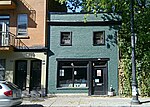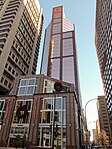Marlborough Apartments
Apartment buildings in QuebecBuildings and structures in MontrealLe Plateau-Mont-RoyalMontreal stubsNational Historic Sites in Quebec ... and 3 more
Quebec building and structure stubsQueen Anne architecture in CanadaResidential buildings completed in 1900

Marlborough Apartments is an apartment building in Montreal, Quebec, Canada. Its address is 570 Milton Street in the Milton Parc neighbourhood. It was designated a National Historic Site of Canada on November 16, 1990.Built in 1900, it is four storeys tall and its facade is red brick. It was designed by architects Taylor and Gordon and is considered to be Queen Anne style architecture.The building's front entrance and facade were used prominently in the 2004 Québécois film Love and Magnets (Les Aimants in French), directed by Yves Pelletier.
Excerpt from the Wikipedia article Marlborough Apartments (License: CC BY-SA 3.0, Authors, Images).Marlborough Apartments
Avenue Lorne, Montreal Plateau Mont-Royal
Geographical coordinates (GPS) Address Nearby Places Show on map
Geographical coordinates (GPS)
| Latitude | Longitude |
|---|---|
| N 45.5074 ° | E -73.5762 ° |
Address
Avenue Lorne 3517
H2X 1T9 Montreal, Plateau Mont-Royal
Quebec, Canada
Open on Google Maps










